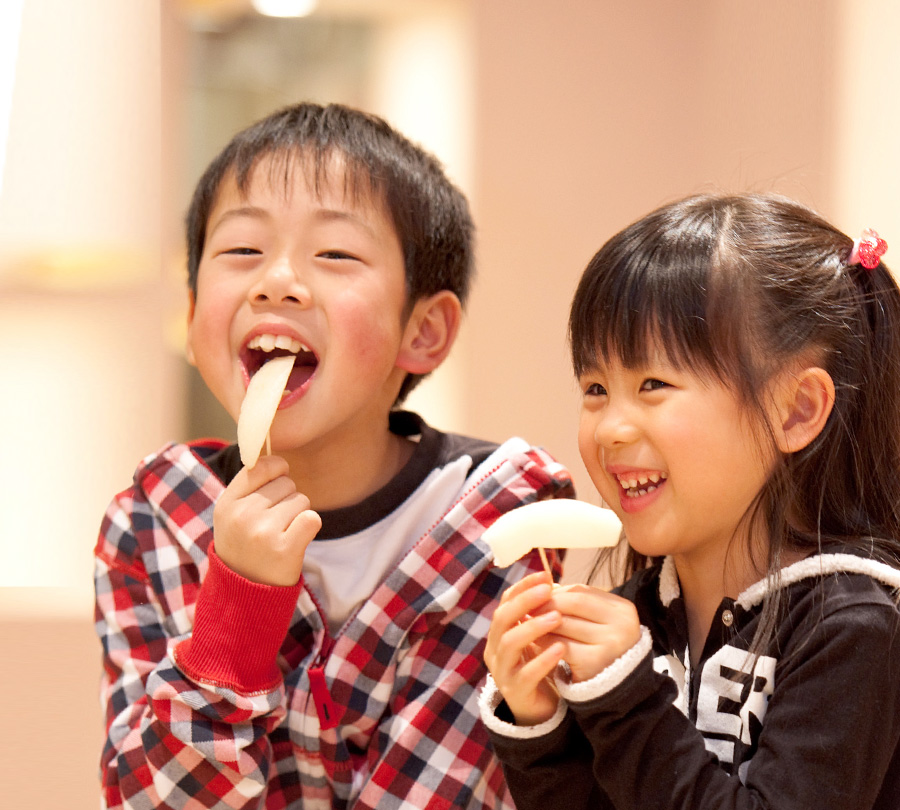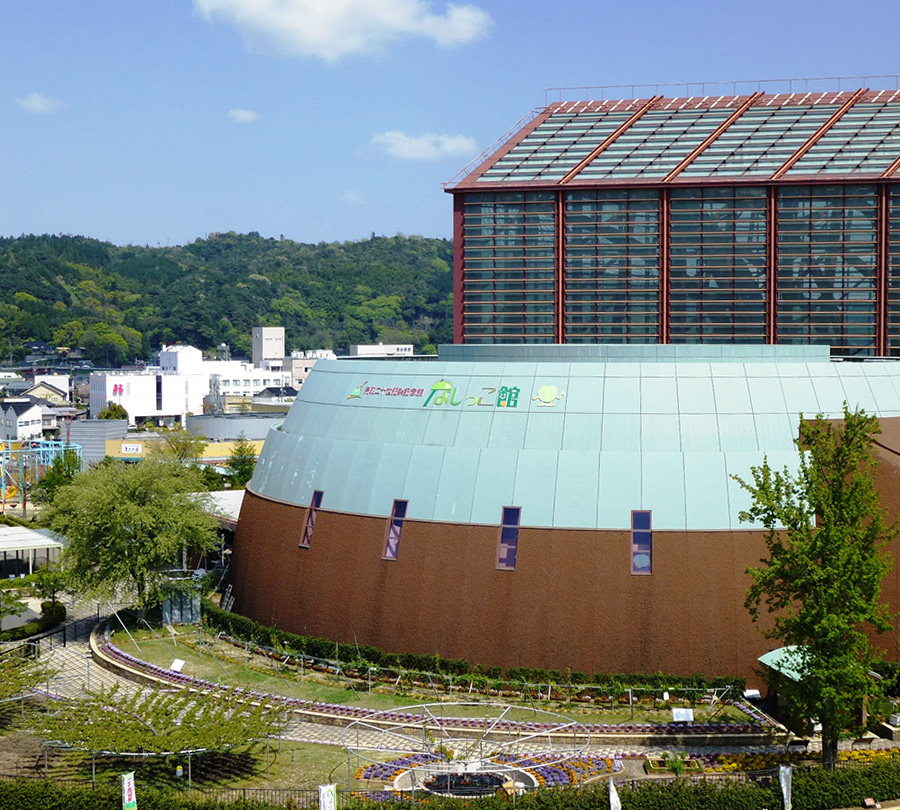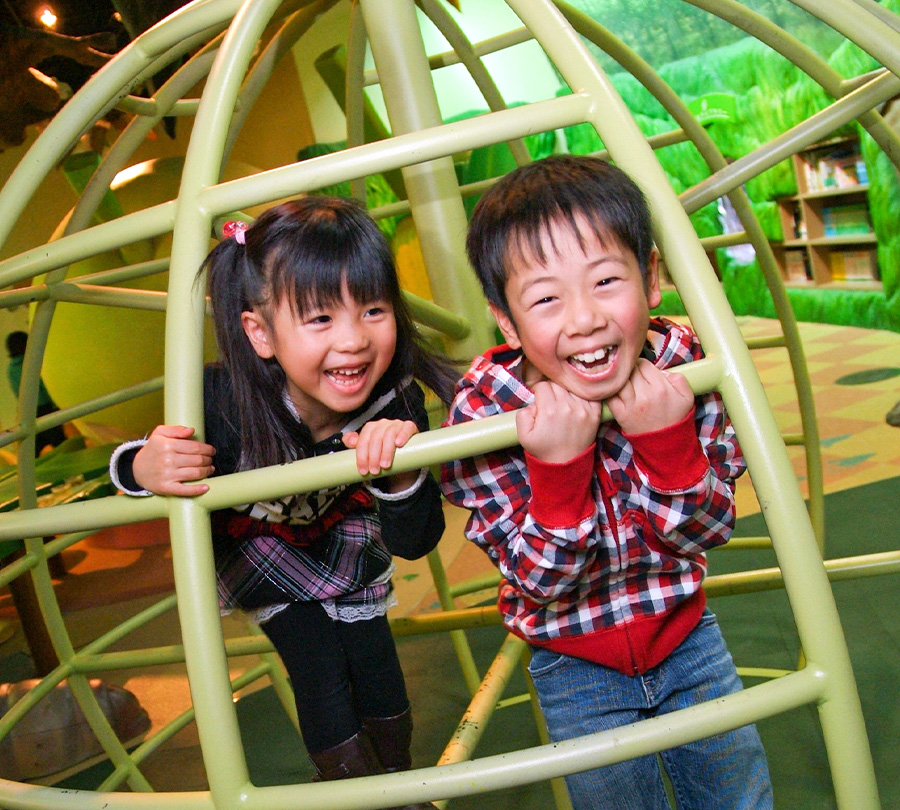acepack Nashikkokan is the only museum in Japan dedicated to pears.
Learn and experience the history and cultivation of pears.
Taste 3 varieties of fresh pear any time of the year!
We heartily await your visit.
Entrance/First Exhibit

The genus of pears originates 70 million years ago in the foothills of a mountainous region in southwest China. Pears that spread to the west became European pears, whereas those that spread to the east became Chinese pears and eventually Japanese pears.
Giant Nijisseiki Pear Tree

The giant Nijisseiki pear tree is the symbolic tree of the Tottori Nijisseiki Pear Museum. It was donated to the museum by Kiyoomi Inamura.
This giant tree has a diameter of 20 meters, and its branches spread over the museum. It is the largest Nijisseiki (20th Century) pear tree in Japan.
The entire tree, including its roots that spread 5 meters underground, are displayed in a glass case.
In 1999, this tree was able to produce 4,000 pears per annum despite being 74 years old. This is five times more than the average tree, which produces about 800 pears a year.
The branches are well-organized and there are buds on every branch. The projecting roots are a result of soil improvement. It would not be an overstatement to say this tree is the accumulation of 100 years of pear making in Tottori.
Nijisseiki Pear Theater

This reenactment of a farmer and his wife uses robots to tell the story about how Nijisseiki pears were grown in the past.
It has been over 100 years since Eiji Kitawaki introduced the Nijisseiki pear to Tottori in 1904.
It would not be an overstatement to say that the biggest challenge was winning the battle against early blight while growing pears.
Early blight started spreading around 1910, and some pear farms were unable to harvest even a single pear because of it. Some prefectures gave up the idea of growing pears entirely.
Tottori was also plagued with early blight. Research was conducted to find ways to prevent it. Farmers, the prefectural government, and Tottori University collaborated together as one to prevent this disease and revive this pear. As a result, Tottori became the top producer of Nijisseiki pears in Japan.
The theater also tells of how Tottori has overcome difficulties in pear production, which include early blight, but also natural disasters and even war.
To recreate the conditions of the old days, the thatched roof is modeled after a farmer's house in the early Showa years, and farm tools that were actually used back in those days are scattered around.
Growing Pears

This corner makes it easy to see how pears are grown throughout the year with a model tree, videos, and panels.
See the process of carefully growing Nijisseiki pears during the year before they reach people's homes by taking a peek through the camera that travels through the diorama.
In the bagging activity corner, you can experience wrapping buds with both small and large bags.
Pear Garden

The Pear Garden has Nijisseiki, a Yamanashi (the forefather of Japanese pears) and 10 other varieties of trees being cultivated and exhibited. Along the outer road of the Pear Garden is a Mamenashi tree. Its flowers are pure white in the spring and its leaves turn scarlet red in the autumn. Enjoy the harmonious view of pears here.
Theater

Watch the videos "Path of Pear" and "Tottori, Soaring Towards the Future of Pear Production".
Path of Pair is based on the theory that pears came from Ancient China through the silk road, to the Korean peninsula, and made it ways to Japan. This fantastic narrative introduce pear farms, the lifestyle, and culture of China, and also covers the history of this museum's symbolic tree, the Giant Nijisseiki Tree.
Tottori, Soaring Towards the Future of Pear Production introduces how pears are currently made and innovations in the near future.
The two films are shown in tandem 30 minutes apart. Check the times for the film you wish to see.
Pear Art Gallery

This corner introduces cultural aspects involving pears.
There are three panels about pears, Japanese paper dolls of seven pear-related stories, and even stamps around the world designed with fruit images. You can also see the haiku of Kochi Kobayashi Isao and the tanka of Wakayama Mizunami.
Pear Kitchen Gallery
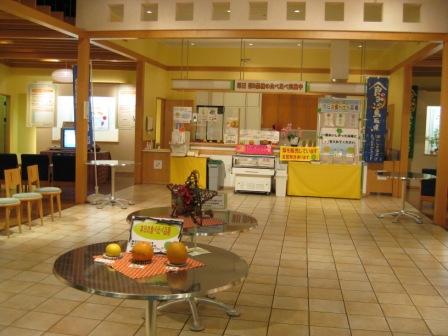
At the Pear Kitchen Gallery, visitors can sample three types of pears all year long.
This is the most popular corner in the Nijisseiki Pear Museum.
You can enjoy pears that are in season, but hyo-on (ice temp) storage technology also allows visitors to sample pears harvested from within the past nine months. Sample all three and vote for your favorite.
There are many highlights to this space, where you can learn about the different varieties, nutritional components and efficacy of pears. Winners of the All Japan Big Pear Tree Contest are also on display. You can enjoy tasting the pears and also learning about them.
Pears and People of the World

This corner shows content about pears from around the world.
The 70 pear replicas were made to be realistic. Originating in China, pears traveled along the silk road to the west and also spread to Japan. You can see the transformation of European pears and Japanese pears.
The Pear World Map shows the production of pears in each country. You can also see a video of pears being grown on the monitors.
At the furthest end of this corner is the Korean corner. See various aspects of Korea, another country that has incorporated pears into everyday life.
Garden of Wonder: Playing with Pears

The Pear Garden of Wonder is an exhibit based on a pear farm where you are miniaturized. You can enjoy the exhibit while learning.
There are cicadas, crows, and rabbits hiding in the garden. Try to find them.
Some are hiding in the cave, so keep your eyes peeled. Pull out the drawers and press various buttons. There are many surprises that await you.
Video Learning Booth

The Video Learning Booth is where eight pear experts in the prefecture tell you the secrets to cultivating good pears through a video. You can see the pruning techniques of an exemplary farmer and watch soil improvement with commentary.
Reference Exhibit

You can see indispensable machinery and tools used in pear production and stickers attached to cargo from the Taisho Period to now.
The "Tools for Tottori's Nijisseiki Pear Production" was registered as a Tangible Folk Asset of Japan.
Fruit Parlor
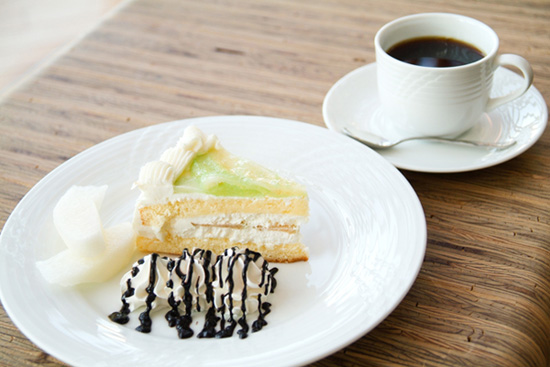
Enjoy and a variety of juices and desserts!
Try our specialty 20th Century Pear Soft Cream (¥300)!
Local brand Tougosan puree is used for a harmonious balance of acidity and vanilla.
Museum Shop

Packed with loads of pear products, the Museum Shop is the perfect place to get your Tottori souvenirs!
Products include fresh pears, pear pudding, pear cake, pear rusks and other sweets, pear juice, pear jam, pear tea, and many more pear inspired products that will surprise you!
Visitation Information
Opening Hours
9:00 to 17:00 (Entrance close at 16:40)
Closed
Every 1st, 3rd and 5th Monday (Or the first work day if after a long weekend)
December 29th -January 3rd
Entrance Fee
Under 6 year olds - Free
6-15 year olds - ¥150
Over 15 year olds - ¥300
<Bus from Kurayoshi Station Bus Terminal>
Take the "Nishi Kurayoshi, Ikuta Shako, Hirose" (西倉吉、生田車庫、広瀬) Bus from Terminal 2.
Get off at
・Kurayoshi Park Square (倉吉パークスクエア) (12mins)
・Kurayoshi Park Square Kitaguchi (倉吉パークスクエア北口) (9mins, 5mins walk)
<By Train>
To JR Kurayoshi Station:
・From Osaka - Super Hakuto Limited Express (About 3hrs)
・From Nagoya - Shinkansen and Super Hakuto Limited Express (About 4hrs 20mins)
<Highway Bus>
・From Osaka/Kobe to Kurayoshi Station (About 3hrs 30mins)
・From Hiroshima to Kurayoshi Station (About 4 hrs)
<By Car>
・From Osaka - Chugoku Expressway (中国自動車道) -> Yonago Expressway (米子道) -> R313 from the Yuubara Interchange (湯原IC) (About 3hrs 30mins)
・From Okayama - Okayama Expressway (岡山道) -> Chugoku Expressway -> Yonago Expressway -> R313 from the Yuubara Interchange (About 2hrs)
・Hiruzen Interchange (蒜山IC) to Kurayoshi (R482 -> R313) takes about 50mins, Innosho Interchange (院庄IC) to Kurayoshi (R179) takes about 1hr
<By Plane>
・From Tokyo to Tottori City (Tottori Sand Dunes Konan Airport) (About 2hrs)
・From Tokyo to Yonago City (Yonago Kitarou Airport) (About 2hrs 30mins)




